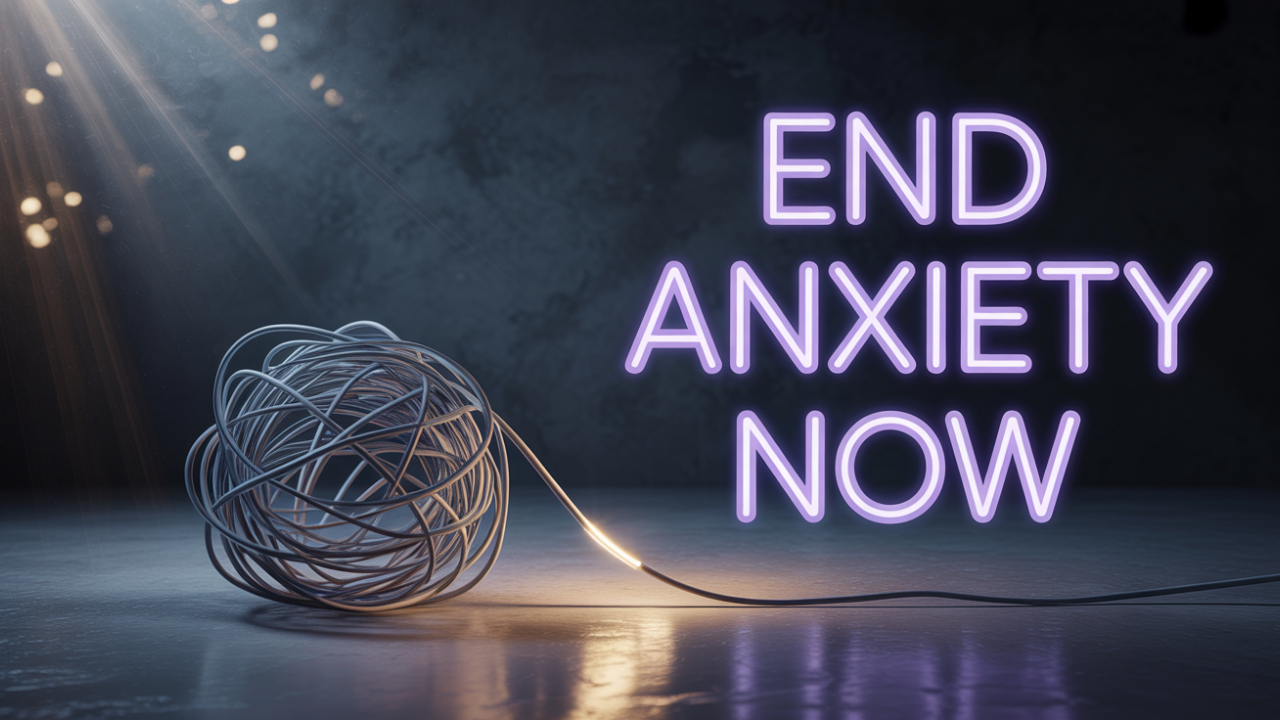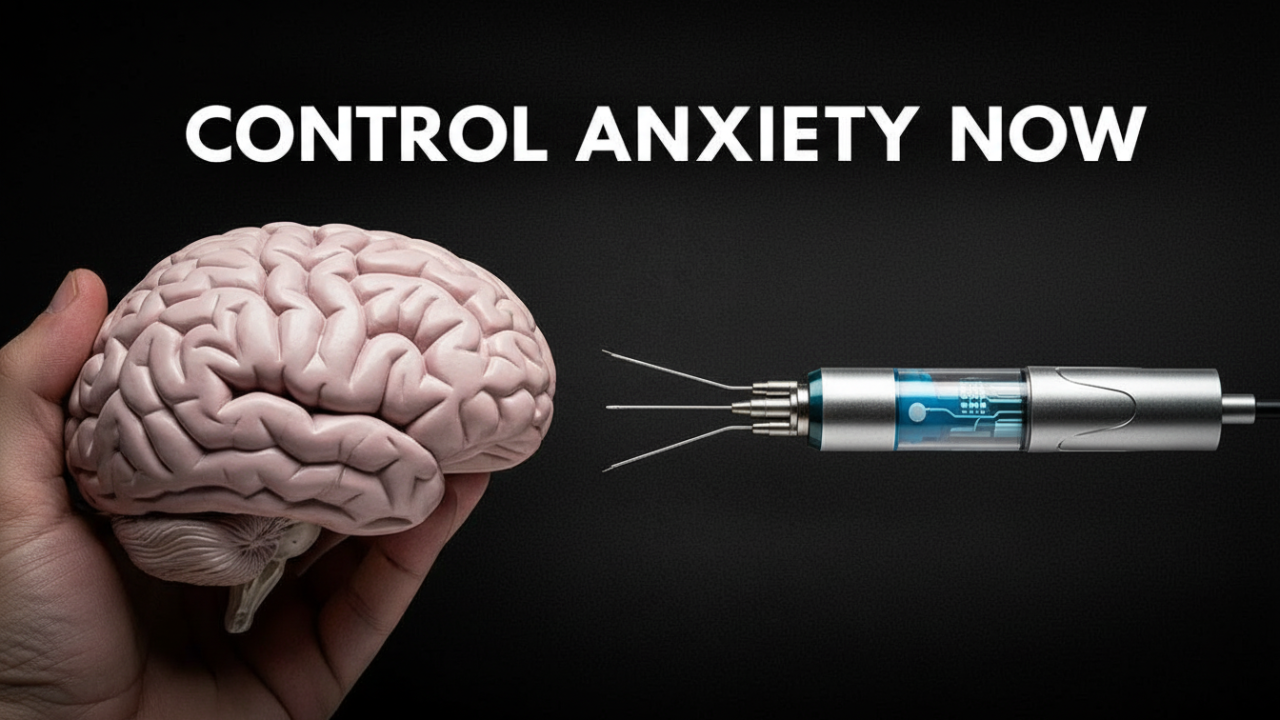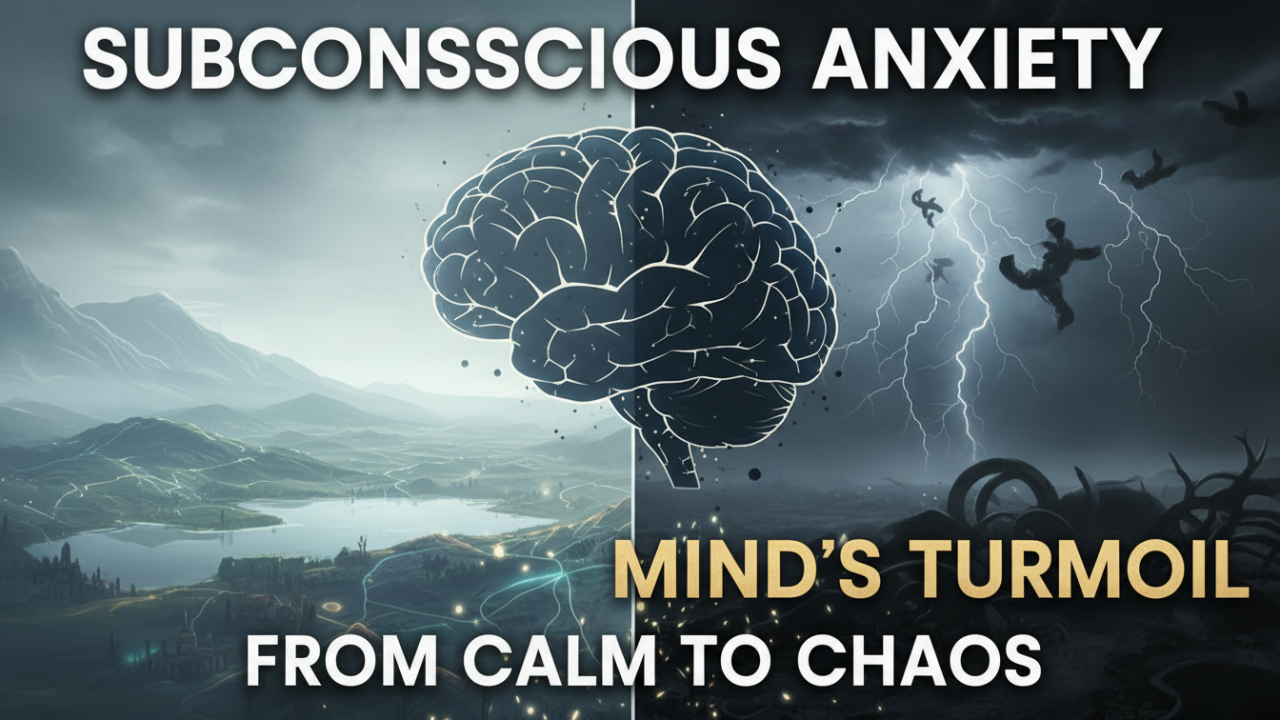Does it ever feel like your own brain is working against you? Like you’re stuck on a looping track of worry, and you just can’t escape your own thoughts? That feeling, like you’re at war with your mind, where fighting the anxiety just makes it spin faster… it’s exhausting. And it’s isolating. But you’re not broken. Your brain isn’t your enemy. It’s just running an old program it learned—a program of fear that’s become way too sensitive.
But what if I told you that you can actually give your brain a new program? The science of neuroplasticity shows us that our brains have a natural, built-in ability to reorganize themselves by forming new connections based on our experiences and thoughts. It means change isn’t just possible; it’s how your brain is designed to work. In this article , I’m not just going to tell you that you can change. I’m going to give you a clear, actionable, 21-day protocol to do exactly that. It’s a step-by-step guide to weaken the anxiety pathways and build new, resilient pathways to lasting peace. So, if you’re ready to stop being a passenger in your own mind and start taking the wheel, stay with me.
I’m Dr. Evelyn Reed, a clinical psychologist specializing in neuropsychology and anxiety disorders. For over fifteen years, I’ve worked with so many people who felt just like you might be feeling right now: trapped. They thought their anxiety was a permanent part of who they were, like a life sentence. But what I’ve seen, time and time again, is that your brain is incredibly adaptable. The main thing I want you to hear today is this: Your anxiety comes from well-worn neural pathways, like deep grooves carved into the ground by water flowing for years. This protocol is our way of deliberately digging new riverbeds to redirect that flow toward calm and clarity.
We’re going to do this together, over the next three weeks. We’ll start with understanding your brain, move to actively rewiring it, and finish by making these new habits stick. This isn’t about just “thinking positive” or ignoring your fears. It’s about fundamentally changing the structure and function of your brain with targeted, daily practice.
This book is scientific documentary of the Kingdom of God.
**Section 1: The “Anxious Brain” Explained – Understanding the Cycle of Fear**
Before we can rebuild, we need to understand the layout. When you feel anxiety, it’s not just a vague feeling; it’s a specific chain reaction happening in your brain. Let’s imagine your brain has two key players in this story: the smoke detector and the watchtower.
The smoke detector is a small, almond-shaped part of your brain called the **amygdala**. Its only job is survival. It’s constantly scanning for threats, and it doesn’t know the difference between a real bear in the woods and the imagined disaster of a work presentation. When it senses danger, it sounds the alarm. We call this the “fight-or-flight” response. It unleashes stress hormones like cortisol and adrenaline, making your heart race, your breathing get shallow, and your muscles tense up. This system is brilliant for saving your life, but it becomes a problem when it’s overactive and firing alarms for things that aren’t actually life-threatening.
The watchtower is your **prefrontal cortex**, right behind your forehead. This is the logical, rational part of your brain. It’s responsible for problem-solving and emotional regulation. Its job is to look at the situation and say, “Okay, the smoke detector is going off. But is there a real fire, or did someone just burn the toast?” It gives context that the amygdala just doesn’t have.
In a non-anxious brain, these two work as a team. The amygdala yells “Danger!” and the prefrontal cortex calmly checks things out and, if there’s no real threat, sends an “all-clear” signal back to the amygdala to stand down.
But in a brain with chronic anxiety, this system is out of whack. The amygdala becomes hypersensitive. It starts seeing threats everywhere—in a vague text message, a weird look from a stranger, or an unanswered email. At the same time, the prefrontal cortex gets worse at calming it down. Chronic stress actually weakens the connection between your rational brain and your emotional brain.
This creates a vicious feedback loop. The amygdala fires, your body floods with stress hormones, and your prefrontal cortex, instead of calming things down, gets hijacked. It starts worrying *about* the anxiety itself. “Why is my heart beating so fast? Am I having a heart attack? What if this feeling never stops?” Your amygdala hears these worried thoughts and thinks they are *more threats*, so it sounds the alarm even louder.
That’s the anxiety cycle. A trigger fires up the amygdala. Your body reacts. Your thinking brain misinterprets the reaction as proof of danger, which fires up the amygdala even more. Round and round it goes, and with each loop, you strengthen that neural pathway.
This is where that famous saying comes from: **”Neurons that fire together, wire together.”**
Every time you run that anxiety loop, you’re practicing anxiety. You’re making that pathway faster and more automatic until it becomes your brain’s default. Your brain, trying to keep you safe, has learned the *habit* of anxiety. Our 21-day protocol is designed to interrupt this cycle and use that same principle to build and strengthen new, calmer pathways. We’re going to teach your brain a new habit: the habit of peace.
Now, let’s be real about the timeline. You’ve probably heard it takes 21 days to form a habit. That idea came from a plastic surgeon, Dr. Maxwell Maltz, who noticed it took his patients about that long to get used to their new faces. But modern research tells us it’s a bit more complicated. A study from University College London found it takes, on average, about 66 days for a new habit to feel automatic, and the range can be anywhere from 18 to 254 days.
So, why 21 days? Because 21 days is a powerful timeframe to lay the foundation. It’s long enough to consciously break old patterns and start wiring new ones. Think of it like building a house: in 21 days, you can clear the land, pour the foundation, and put up the frame. The weeks and months after are for finishing the inside. This protocol is that critical construction phase. It will take consistent, daily effort. But by the end, you’ll have built the framework for a new way of being.
**Section 2: The 21-Day Brain Rewiring Protocol**
Alright, this is where the real work begins. This protocol is split into three one-week phases. Each week builds on the last, guiding you from reactive anxiety toward conscious calm. Remember, consistency is everything. It’s not about being perfect; it’s about persistent practice. Even 10-15 minutes of focused effort each day can start to reshape your brain.
**Week 1: Mindful Recognition (Days 1-7) – *The Art of Noticing***
The first step in rewiring your brain is to stop mindlessly running the old program. This week, your only job is to become a curious observer of your own mind. We’re not trying to stop the anxiety, fight it, or fix it. We are simply going to notice it. This act of observing without judgment is a huge first step. It starts to engage your prefrontal cortex—your watchtower—pulling power away from the reactive amygdala. By simply naming what you’re feeling, you shift from being *in* the anxiety to *observing* it. That creates a little bit of space, and that space is where our work begins.
**Your Daily Practice for Week 1 (15 minutes/day):**
**Find a Quiet Space (2 minutes):** Just start by sitting comfortably. You don’t need a special cushion or a silent room, just a spot where you can be uninterrupted for a few minutes. Close your eyes or just soften your gaze.
**Focus on Your Breath (3 minutes):** Bring all your attention to the physical feeling of your breath. Feel the air come in, fill your lungs, and then feel your chest fall as you exhale. Your mind *is* going to wander. That’s what minds do. When it happens, just gently and kindly guide your attention back to your breath. Every time you bring it back, you’re doing a rep for your prefrontal cortex, strengthening its ability to focus.
**The “Notice and Name” Technique (10 minutes):** For the rest of the time, and as you go about your day, your job is to be a detective for your own anxiety.
**Notice the Trigger:** What just happened? Was it a thought, a memory, an email? Just note it.
**Name the Emotion:** Silently say to yourself, “This is anxiety,” or “Worry is here,” or “That is a fear-based thought.” When you label it, you activate the language parts of your prefrontal cortex, which helps turn down the amygdala’s alarm.
**Acknowledge Without Judgment:** This is the most important part. Don’t beat yourself up for feeling anxious. Don’t try to shove the feeling away. Just acknowledge it like a scientist observing the weather. You could say to yourself, “Ah, interesting. The ‘I’m going to mess up’ thought just showed up, and it brought a feeling of anxiety with it.” This calm, non-reactive stance breaks the anxiety cycle.
**Week 1 Deep Dive:**
**Day 1 & 2:** Just focus on naming the big, obvious waves of anxiety. Don’t go looking for them. Just when you feel one, say, “Ah, there’s anxiety.”
**Day 3 & 4:** Now, get a little more specific. Notice the *physical* sensations. “My chest feels tight.” “My stomach is in a knot.” Name them without calling them “bad.” They’re just energy and information. This helps detach the physical feeling from the scary story your mind wants to tell about it.
**Day 5 & 6:** Start noticing the specific *thoughts* that come with the feeling. Jot them down in a journal if that helps. Is it a “what if?” thought? A self-critical thought? Just observe them like clouds passing by. You are the sky, not the clouds.
**Day 7:** Reflect on the week. What did you notice? Any patterns? The goal isn’t to have *less* anxiety by Day 7. The goal is to be much more *aware* of it. That awareness is the foundation for everything else. You’ve successfully started to weaken the automatic habit of anxiety.
**Week 2: Active Reframing (Days 8-14) – *Challenging the Story***
Now that you’ve practiced watching your anxious thoughts, it’s time to talk back to them. In Week 2, we go from passive observer to active questioner. This part is based on Cognitive Behavioral Therapy, or CBT, one of the most proven methods for treating anxiety. The main idea is that our feelings aren’t caused by events, but by how we *interpret* those events. Anxious thinking is full of predictable mental traps called “cognitive distortions.”
Our goal this week is to catch these distorted thoughts, challenge them, and consciously replace them with more balanced and realistic ones. This isn’t about pretending everything is fine; it’s about thinking *accurately*. Every time you challenge a warped thought and suggest a more realistic one, you’re literally carving a new neural pathway.
**Common Cognitive Distortions to Look For:**
**Catastrophizing:** Expecting the absolute worst. “If I make one mistake, I’ll get fired.”
**All-or-Nothing Thinking:** Seeing things in black and white. “I didn’t finish everything on my list, so today was a total failure.”
**Mind Reading:** Assuming you know what other people are thinking. “I know they all think I’m an idiot.”
**Emotional Reasoning:** Believing something must be true because you feel it so strongly. “I feel terrified, so something terrible must be about to happen.”
**Overgeneralization:** Seeing a single negative event as a never-ending pattern. “I always mess things up.”
**Your Daily Practice for Week 2 (15-20 minutes/day):**
Keep noticing your anxiety like you did in Week 1. But now, when you “Notice and Name” an anxious thought, you’ll take the next step: **Challenge and Reframe.** Using a journal for this week is a great idea.
**The 4-Column Technique:**
Grab a notebook and make four columns:
**Situation:** What was the trigger? (e.g., “Boss emailed me asking for a quick chat.”)
**Automatic Thought/Feeling:** What was the first thought that popped into your head? How did it feel? (e.g., “Oh no, I’m in trouble.” Feeling: Panic, 8/10).
**Challenge (The Cross-Examination):** Now, become a gentle detective. Question that thought.
*”What’s the evidence for this thought? What’s the evidence against it?”* (Evidence For: None, really. Against: My last project went well. “Quick chat” is neutral.)
*”Am I falling into a thinking trap here? (Catastrophizing? Mind Reading?)”* (Yes, definitely mind reading and catastrophizing.)
*”What’s a more realistic way to see this?”* (It could be about anything. Maybe it’s a new assignment. Most of our chats have been fine.)
*”What would I tell a friend who had this thought?”* (I’d tell them not to jump to conclusions and just see what it’s about.)
**Reframe:** Write a new, more balanced thought. (e.g., “My boss wants to chat. I don’t know what it’s about, so assuming the worst isn’t helpful. I’ll go in with curiosity. Even if it’s feedback, I can handle it.”)
**Week 2 Deep Dive:**
**Days 8-10:** Just focus on one or two thinking traps you noticed you fall into a lot. If you’re a catastrophizer, make it your mission to catch and challenge every catastrophic thought you find.
**Days 11-12:** Really practice the 4-Column Technique with at least one anxious thought each day. It might feel slow or awkward at first. That’s fine. You’re building a new mental muscle.
**Days 13-14:** Try to do the reframing process in your head, without the journal. Catch a thought, question it, and offer yourself a better alternative. Notice how it feels. Does the anxiety drop from an 8 to a 5? That’s a huge win. You’re proving to your brain it doesn’t have to believe every scary thought it has.
By the end of Week 2, you’ve gone from being a passive observer to an active participant. You’re learning to question anxiety’s authority and proving to yourself that you have the power to change the narrative.
**Week 3: Intentional Action (Days 15-21) – *Living the Change***
Thinking differently is essential, but it’s action that makes the change stick. In Week 3, we take our new perspectives and translate them into real-world behavior. Your brain learns by doing. When you act in a way that goes against your anxiety, you send the loudest possible message to your amygdala: “See? False alarm. We did the ‘scary’ thing and we survived. We’re safe.” This is how we pour the concrete for our new, calmer neural pathways.
This week is all about **Behavioral Activation**. Anxiety tends to make our worlds smaller as we avoid things that trigger it. This week, we’re going to strategically and gradually re-engage with a life that’s guided by your values, not your fears. We’ll also bring in physical techniques that use your body to calm your mind.
**Your Daily Practice for Week 3 (20-30 minutes/day):**
**”Valued Action” Planning (5 minutes):** Each morning, pick one small action you can take that aligns with your values (like connection, growth, or health) but that anxiety might usually make you avoid. This isn’t about throwing yourself into a terrifying situation. It’s about taking one small, courageous step.
*If you value connection:* Text a friend you haven’t talked to in a while.
*If you value health:* Go for a 15-minute walk, even if you don’t feel like it.
*If you value growth:* Spend 10 minutes learning something new online.
**Somatic Calming Techniques (10 minutes):** Your mind and body are a two-way street. You can use your body to help your brain. Practice one of these each day, especially when you feel the physical symptoms of anxiety kick in.
**Diaphragmatic Breathing (Box Breathing):** This is one of the quickest ways to switch on your body’s “rest and digest” system. Inhale slowly for 4 counts, hold for 4, exhale slowly for 4, and hold the exhale for 4. Repeat for 5-10 cycles. This physically slows your heart rate and tells your amygdala you’re safe.
**Progressive Muscle Relaxation:** Tense and then release different muscle groups to let go of physical tension. Start with your toes: tense them hard for 5 seconds, then release for 10 seconds, really noticing the difference. Work your way up your body: calves, thighs, stomach, fists, arms, shoulders, and face. This makes you aware of where you hold tension and teaches your body what deep relaxation feels like.
**Execute Your Valued Action (Time Varies):** Sometime during the day, do that one small thing you planned. Before you do it, notice any anxiety that comes up. Use your Week 1 and 2 skills. Notice the thought (“This is going to be awkward”), challenge it (“Maybe, but connecting with my friend is more important”), and then *do it*.
**Positive Experience Absorption (5 minutes):** At the end of the day, reflect on the action you took. Don’t just check it off a list. Spend a few minutes savoring anything good about it. Did the walk feel nice? Was it good to hear back from your friend? This practice is about actively soaking in the good stuff to counteract our brain’s natural tendency to focus on threats. By focusing on the good, you’re fertilizing those new neural pathways.
**Week 3 Deep Dive:**
**Days 15-17:** Start with very small, easy actions. The goal is to build momentum and prove to yourself that you can do it.
**Days 18-19:** Maybe choose something a little more challenging. Speak up once in a meeting. Make a phone call you’ve been putting off. Use your breathing techniques to ground yourself first.
**Days 20-21:** On the final days, look back on the entire 21-day journey. Read your journal from Week 1. Notice how far you’ve come. You started as a victim of the anxiety cycle, became a scientist of your mind, then a debater against your own negative thoughts, and finally, an architect of your own behavior. That’s the path of rewiring.
By finishing this week, you’ve shown your brain that anxiety is no longer the boss. You’re using your thoughts, your body, and your actions together to build a new default mode—one of resilience, courage, and calm.
**Conclusion: Your Brain, Your Ally**
So where does that leave us? We’ve looked at the neuroscience of the anxious brain—that battle between the hyperactive amygdala and the overwhelmed prefrontal cortex. And more importantly, we’ve laid out a clear, three-week plan to turn the tide in that battle. We moved from Mindful Recognition, to Active Reframing, and finally to Intentional Action.
If you take one thing away from this article , let it be this: Your brain is not your enemy. It was just trying to protect you with an old, outdated program. But you now have the tools to give it an update. Through the incredible power of neuroplasticity—your brain’s own ability to change—you can become its master programmer.
This 21-day protocol isn’t a magic cure. You’ll still have days when anxiety shows up. But this is the start of forging new habits and new pathways. It’s the beginning of a new relationship with your own mind, one built on awareness, kindness, and intentional choice. You’ve learned how to stop being swept away by the river of anxiety and instead, how to stand on the bank, observe its flow, and consciously choose to walk a different path—a path you build yourself, one day at a time. You are not trapped. You are adaptable. And your journey to reclaiming your mind starts now. Thank you for taking this time for yourself. Keep practicing, be patient, and never forget the incredible power you have to change your own brain.







